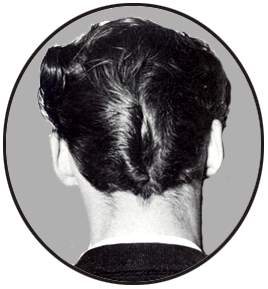If you’re wondering what is a ducktail haircut, also known as the D.A. or duck butt then this page is for you. Ducktail is an iconic hairstyle from the 1950s that has left an indelible mark on fashion history. The 1950s were a hotbed of change, rebellion, and youth culture, and the ducktail was right in the middle of it all.
Other than the poodle skirt, no other symbol of the Fifties has captured the imagination and endured so well.
Also called the D.A. or duck butt, the style requires that you comb the hair back to the middle of the head, then with the end of a rattail comb, make a center part.
Let us consider its contribution to the term “greasers.” To accomplish this look, lots of hair grease is required. In this case, a little dab ain’t gonna do ya. In the 50s you may remember,
there were no blow dryers to create a look. To make hair stay in a certain style, you had to either spray or grease. Well, real men didn’t spray.
The D.A. quickly identified a guy as a rebel, a non-conformist. Although once everyone in a group does an identical thing, such standardization is conformity, but hey, it’s remains cool compared to the mainstream.
Although the ducktail was adopted lovingly by Hollywood to represent the wild youth of the Fifties, the fact is that only a small minority of guys actually sported a D.A.

Most fellas looked more like that guy. The crewcut was the hair style of choice for many young men. So was a do known as the flat top. What’s the difference?
Herbert Klug explains:
“The crewcut was one type of cut and the flat top was
totally different. In the crew cut, the hair was shaved to an even distance all
over the head. The top of the head was rounded. This was also called a “butch
haircut”. It was the sort of hair cut that one would get if one went into the
military. In the flat top, the sides were shaved close, but what made it
different was the hair on the top of the head was allowed to grow longer and
was then cut off in one level plane so that it produced a “flat top”.
 Adult men weren’t allowed much hair within the confines of respectability. A short, neatly trimmed cut such as that at left was standard.
Adult men weren’t allowed much hair within the confines of respectability. A short, neatly trimmed cut such as that at left was standard.
By the way, for those of you too young to know – that’s Cary Grant. I chose him because he exuded a timeless class which still endures.
The ducktail haircut isn’t just a hairstyle; it’s a symbol of rebellion, an artifact of the ’50s, and a timeless classic. I’ve enjoyed every moment of exploring its history and sharing the secrets of styling it. Whether you’re a fellow hairstylist, a history buff, or just someone who’s curious about this iconic look, I hope this guide has added a touch of coolness to your day.
A Step-by-Step Guide to Getting The Perfect Ducktail:
Achieving that classic ducktail look involves careful styling and attention to detail. Here’s how you can create this iconic hairstyle:
Step 1: Gather Your Tools and Products:
To get started, you’ll need the following:
- A fine-toothed comb
- A rattail comb for parting
- Hair pomade or grease (yes, you’re going to need some)
- A mirror (preferably one that can be adjusted)
Step 2: Start with Clean, Damp Hair:
Begin by washing your hair and drying it until it’s slightly damp. This will make it more manageable for styling.
Step 3: Create a Center Part:
Use your rattail comb to create a clean center part from your hairline to the back of your head. This is where the signature ducktail split will form.
Step 4: Comb Backward:
Comb your hair backward from the forehead toward the crown of your head. Make sure it’s smooth and well-combed.
Step 5: Form the Ducktail Split:
Now, with the end of your rattail comb, create the distinctive “ducktail” split down the middle of your combed-back hair. This is a key element of the style.
Step 6: Apply Hair Pomade or Grease:
Here’s where the magic happens. Take a generous amount of hair pomade or grease (in the 1950s, they used a lot!), and work it evenly through your hair. Pay special attention to the split in the center; it should be well-coated.
Step 7: Sculpt the Ducktail:
Using your hands, start sculpting the ducktail shape. The sides should taper down, and the center split should stand out distinctly. You can also use your fine-toothed comb to refine the shape as needed.
Step 8: Check Your Work:
Take a moment to check your hairstyle in the mirror from different angles. Ensure that the ducktail is symmetrical and that the sides are neatly combed down.
Step 9: Final Touches:
If you want a truly authentic look, you can use a bit more pomade or grease to add some shine and hold to your hair. Be sure not to overdo it; a little goes a long way.
Step 10: Lock It in Place:
To keep your ducktail looking sharp all day, you can use a light hairspray or a similar product to set the style.
And there you have it—a step-by-step guide to achieving the perfect ducktail haircut. Remember, practice makes perfect, so don’t be discouraged if it takes a few tries to get it just right. With patience and a steady hand, you’ll master this classic ’50s style in no time – you may even want to try pompadour hairstyle. Enjoy your new look!
